Sunday, September 29, 2013
Donate to Young People's Pavilion and Help Children Read
This site is a labor of love designed to help children, educators, parents and librarians in the ever changing and complex world of children’s literature. Your donation of $5, $10, $15, $25, $50, $100, $500 or more will help ensure that we can continue the fight to promote literacy!
Wednesday, September 25, 2013
Poetry Time With Charles Waters
Meet actor and poet Charles Waters:
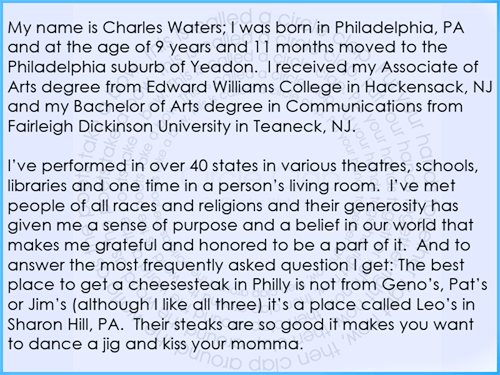
Poetry column: Joy erupts into poetry explosion, promotes literacy

By MICHAEL HOOVER
For The Evening Sun
EXCERPT:
Katie Lasky and Charles Waters, two treasures of humanity employed by Poetry Alive!, spent the past couple weeks involving Adams County students in the memorization and performance of poetry by noted poets past and present.
Students work collaboratively to break poems into dramatic presentations complete with characters, dialog, and setting – all taken from the text of the poems. Kids and adults have so much fun getting lost in the creativity that abounds, even in multiple presentations of the same poem.
Lasky and Waters possess such electricity that the federal government should tap them as an alternative energy source.
The theatric partners spontaneously broke into performance in KClinger’s dining room as though they were playing on stage to a crowd of hundreds.
They were hilarious, complementing one another and building off one another’s banter enough to arouse rapt attention, laughter, and applause from perfect strangers. Lasky herself is a former stand-up comedienne.
Waters, whose extensive background includes Shakespearean performances and whose glass was filled with ginger ale all evening, initiated the evening’s performance art with a dramatic, booming rendition to the whole of the establishment, making even the jukebox pale in decibel level. It’s easy to see that his love for children’s poetry has influenced the humor and encouragement behind this poem …
READ THE FULL TEXT HERE
In this video, Charles performs the following children’s poems: I wear mommy’s dress, Good News! Good News! and I Love Pie
___
MORE INFO IS AVAILABLE AT www.charleswaters.net/
Labels:
Charles Waters,
Conferences,
county students,
Creative Writing,
energy source,
evening sun,
ginger ale,
michael hoover,
NJ,
Philadelphia,
Poetry,
Poetry Alive,
poets,
The Evening Sun
The Cybermen are Back in Doctor Who: “Nightmare in Silver!”
In Doctor Who, Season 7 Part 2, Ep. 7 “Nightmare in Silver,
”
Hedgewick’s World of Wonders was once the greatest theme park in the galaxy, but it’s now the dilapidated home to a shabby showman, a chess playing dwarf and a dysfunctional army platoon. When the Doctor, Clara, Artie and Angie arrive, the last thing they expect is the re-emergence of one of the Doctor’s oldest foes. The Cybermen are back!
Hedgewick’s World of Wonders was once the greatest theme park in the galaxy, but it’s now the dilapidated home to a shabby showman, a chess playing dwarf and a dysfunctional army platoon. When the Doctor, Clara, Artie and Angie arrive, the last thing they expect is the re-emergence of one of the Doctor’s oldest foes. The Cybermen are back!
Doctor Who
is a British science fiction television program produced by the BBC.
The program depicts the adventures of a Time Lord—a time travelling,
humanoid alien known as the Doctor. He explores the universe in his
‘TARDIS’, a sentient time-travelling space ship. Its exterior appears as
a blue British police box, a common sight in Britain in 1963, when the
series first aired. Along with a succession of companions, the Doctor
faces a variety of foes while working to save civilizations, help
ordinary people, and right wrongs.
The show has received recognition from critics and the public as one of the finest British television programs, winning the 2006 British Academy Television Award for Best Drama Series and five consecutive (2005–10) awards at the National Television Awards during Russell T. Davies’s tenure as Executive Producer. In 2011, Matt Smith became the first Doctor to be nominated for a BAFTA Television Award for Best Actor. In 2013, the Peabody Awards honoured Doctor Who with an Institutional Peabody “for evolving with technology and the times like nothing else in the known television universe.”
The program is listed in Guinness World Records as the longest-running science fiction television show in the world and as the “most successful” science fiction series of all time—based on its over-all broadcast ratings, DVD and book sales, and iTunes traffic. During its original run, it was recognised for its imaginative stories, creative low-budget special effects, and pioneering use of electronic music (originally produced by the BBC Radiophonic Workshop).
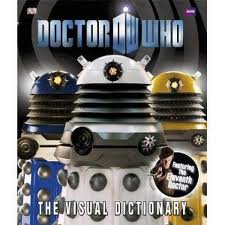 Doctor Who: The Visual Dictionary
is now updated with all the latest information on all your Doctor Who
favorites! The book goes beyond the story lines to examine the
characters, aliens, weapons and curiosities that are all in a day’s work
for the Doctor. Entries are illustrated with annotated photography and
specially commissioned cross-section artworks.
Doctor Who: The Visual Dictionary
is now updated with all the latest information on all your Doctor Who
favorites! The book goes beyond the story lines to examine the
characters, aliens, weapons and curiosities that are all in a day’s work
for the Doctor. Entries are illustrated with annotated photography and
specially commissioned cross-section artworks.
Eleven actors have headlined the series as the Doctor. The transition from one actor to another is written into the plot of the show as regeneration, a life process of Time Lords through which the character of the Doctor takes on a new body and, to some extent, new personality, which occurs when sustaining injury which would be fatal to most other species. Although each portrayal is different, and on occasions the various incarnations have even met one another, they are all meant to be aspects of the same character. The Doctor is currently portrayed by Matt Smith, who took up the role after David Tennant’s last appearance in an episode broadcast on 1 January 2010.
The show has received recognition from critics and the public as one of the finest British television programs, winning the 2006 British Academy Television Award for Best Drama Series and five consecutive (2005–10) awards at the National Television Awards during Russell T. Davies’s tenure as Executive Producer. In 2011, Matt Smith became the first Doctor to be nominated for a BAFTA Television Award for Best Actor. In 2013, the Peabody Awards honoured Doctor Who with an Institutional Peabody “for evolving with technology and the times like nothing else in the known television universe.”
The program is listed in Guinness World Records as the longest-running science fiction television show in the world and as the “most successful” science fiction series of all time—based on its over-all broadcast ratings, DVD and book sales, and iTunes traffic. During its original run, it was recognised for its imaginative stories, creative low-budget special effects, and pioneering use of electronic music (originally produced by the BBC Radiophonic Workshop).
 Doctor Who: The Visual Dictionary
is now updated with all the latest information on all your Doctor Who
favorites! The book goes beyond the story lines to examine the
characters, aliens, weapons and curiosities that are all in a day’s work
for the Doctor. Entries are illustrated with annotated photography and
specially commissioned cross-section artworks.
Doctor Who: The Visual Dictionary
is now updated with all the latest information on all your Doctor Who
favorites! The book goes beyond the story lines to examine the
characters, aliens, weapons and curiosities that are all in a day’s work
for the Doctor. Entries are illustrated with annotated photography and
specially commissioned cross-section artworks.The book updates the entries of Davros and his Daleks, the rhino-headed Judoon and the Doctor s companions Martha Jones and Captain Jack. Forty additional pages introduce and explore all-new characters like the formidable Donna Noble, the Family of Blood and their Scarecrow Henchmen, the warmongering Sontaran and the childlike, but deadly, Toclafane.Doctor Who is a significant part of British popular culture; and elsewhere it has become a cult television favorite. The show has influenced generations of British television professionals, many of whom grew up watching the series. The program originally ran from 1963 to 1989. After an unsuccessful attempt to revive regular production in 1996 with a backdoor pilot in the form of a television film, the program was relaunched in 2005 by Russell T. Davies who was showrunner and head writer for the first five years of its revival, produced in-house by BBC Wales in Cardiff. Series 1 in the 21st century, featuring Christopher Eccleston as the ninth incarnation, was produced by the BBC. Series 2 and 3 had some development money contributed by the Canadian Broadcasting Corporation (CBC), which was credited as a co-producer. Doctor Who also spawned spin-offs in multiple media, including Torchwood (2006) and The Sarah Jane Adventures (2007) – both created by Russell T Davies, K-9 (2009), the four-part video series P.R.O.B.E. (1994), and a single pilot episode of K-9 and Company (1981). There also have been many spoofs and cultural references of the character in other media.
Eleven actors have headlined the series as the Doctor. The transition from one actor to another is written into the plot of the show as regeneration, a life process of Time Lords through which the character of the Doctor takes on a new body and, to some extent, new personality, which occurs when sustaining injury which would be fatal to most other species. Although each portrayal is different, and on occasions the various incarnations have even met one another, they are all meant to be aspects of the same character. The Doctor is currently portrayed by Matt Smith, who took up the role after David Tennant’s last appearance in an episode broadcast on 1 January 2010.
What most schools don’t teach
Learn about a “superpower” that’s not taught in 90% of schools. Help out at http://code.org/
Starring Bill Gates, Mark Zuckerberg, will.i.am, NBA All-star Chris Bosh, Jack Dorsey, Tony Hsieh, Drew Houston, Gabe Newell, Ruchi Sanghvi, Elena Silenok, Vanessa Hurst, and Hadi Partovi. Directed by Lesley Chilcott.
Need subtitles or translations? See http://www.youtube.com/watch?v=nKIu9yen5nc
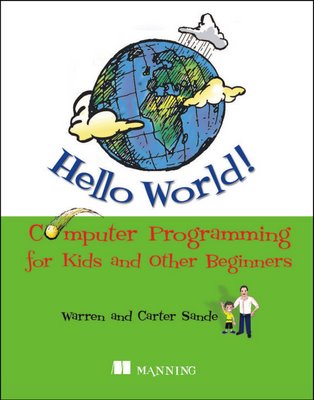
AND SEE:
Your computer won’t respond when you yell at it. Why not learn to talk to your computer in its own language? Whether you want to write games, start a business, or you’re just curious, learning to program is a great place to start. Plus, programming is fun!
Hello World! provides a gentle but thorough introduction to the world of computer programming. It’s written in language a 12-year-old can follow, but anyone who wants to learn how to program a computer can use it. Even adults. Written by Warren Sande and his son, Carter, and reviewed by professional educators, this book is kid-tested and parent-approved.
You don’t need to know anything about programming to use the book. But you should know the basics of using a computer–e-mail, surfing the web, listening to music, and so forth. If you can start a program and save a file, you should have no trouble using this book.
Purchase of the print book comes with an offer of a free PDF, ePub, and Kindle eBook from Manning. Also available is all code from the book.
Starring Bill Gates, Mark Zuckerberg, will.i.am, NBA All-star Chris Bosh, Jack Dorsey, Tony Hsieh, Drew Houston, Gabe Newell, Ruchi Sanghvi, Elena Silenok, Vanessa Hurst, and Hadi Partovi. Directed by Lesley Chilcott.
Need subtitles or translations? See http://www.youtube.com/watch?v=nKIu9yen5nc

AND SEE:
Hello World! Computer Programming for Kids and Other Beginners
“Computer programming is a powerful tool for children to ‘learn learning,’ that is, to learn the skills of thinking and problem-solving…Children who engage in programming transfer that kind of learning to other things.”–Nicholas Negroponte, the man behind the One Laptop Per Child project that hopes to put a computer in the hands of every child on earth, January 2008Your computer won’t respond when you yell at it. Why not learn to talk to your computer in its own language? Whether you want to write games, start a business, or you’re just curious, learning to program is a great place to start. Plus, programming is fun!
Hello World! provides a gentle but thorough introduction to the world of computer programming. It’s written in language a 12-year-old can follow, but anyone who wants to learn how to program a computer can use it. Even adults. Written by Warren Sande and his son, Carter, and reviewed by professional educators, this book is kid-tested and parent-approved.
You don’t need to know anything about programming to use the book. But you should know the basics of using a computer–e-mail, surfing the web, listening to music, and so forth. If you can start a program and save a file, you should have no trouble using this book.
Purchase of the print book comes with an offer of a free PDF, ePub, and Kindle eBook from Manning. Also available is all code from the book.
Where are all the black boys? Author Varian Johnson Highlights a Persistent Gap in Children’s Literature
Ashley Bryan wrote a classic article called the All White World of Children’s Books, in the 1960s.
wrote a classic article called the All White World of Children’s Books, in the 1960s.
How much have things changed since then?
-
 An answer comes from author Varian Johnson, who wrote in his May 15, 2013 blog entry:
An answer comes from author Varian Johnson, who wrote in his May 15, 2013 blog entry:Last week, author and librarian Betsy Bird posted this on Twitter: “At the risk of sounding desperate, can anyone name me just ONE middle grade novel published in 2013 starring an African-American boy?”-She later followed up with a post listing all the books published in 2013 featuring African-American boys as main characters. If I’m counting correctly, the number is somewhere around eight. Maybe ten, when you count some of the small publishers.-You have no idea how depressed this makes me feel. … There are a lot of theories why these books aren’t being published. Maybe authors aren’t writing them. Maybe editors and agents aren’t acquiring them. Maybe readers don’t want them.
Here is some suggested reading on this topic:
-
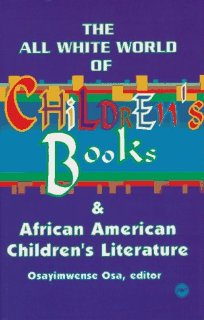 The All White World of Children’s Books and African American Children’s Literature
is a collection of essays represents perhaps the first attempt on the
part of scholars of African American children’s literature to give
scholarly status to the study, analysis, and critique of such
literature, wrote Betty McEady-Gilead of the Journal of Reading.
The All White World of Children’s Books and African American Children’s Literature
is a collection of essays represents perhaps the first attempt on the
part of scholars of African American children’s literature to give
scholarly status to the study, analysis, and critique of such
literature, wrote Betty McEady-Gilead of the Journal of Reading.
Author Osayimwense Osa wrote:
I was a visiting rofessor in 1989/90 in Germany and the US during my sabbatical year, very soon after establishing the Journal of African Children’s Literature (JACL) which later became the Journal of African Children’s & Youth Literature (JACYL). I found quite interesting and fascinating, Dianne Johnson’s book, The Pedagogy and Promise of Literature for African American Youth, which was given to me to review. And when I decided to do a Special Issue Volume 3 on African American Children’s Literature, I contacted her about potential contributors, and sent flyers to various institutions. Her response was very positive. Many wonderful essays were received and the problem of selection for the special issue had to be addressed.
Attending the African Studies Association conference in Boston, MA. in the early 90s, I met Mr. Kassahun Checole, the Mangaging Director of Africa World Press. It was this meeting that resulted in the transformation of the Volume 3 Special Issue on African American Children’s Literature of JACYL into The All-White World of Children’s Books and African American Children’s Literature in 1995.I gratefully acknowledge the support of Dr. Richard F. Abrahamson, Dr. Nancy J. Schmidt, Dr. Dianne Johnson, Dr. Hugh Keenan, Mrs. Kemie Nix, Dr. Mary Twining, Dr. David Dorsey, Dr. Donnarae MacCann, and all the enthusiastic contributors to Volume 3 Special Issue on African American Children’s Literature of JACYL.
Unlike most collections of African American literature, this is
not an anthology of African American literature, nor is it merely a
bibliographic potpourri of books about and for African American children
and youth. Instead, this collection of essays represents perhaps the
first attempt on the part of scholars of African American children’s
literature to give scholarly status to the study, analysis, and critique
of such literature. As scholars in children’s and youth literature
addressing ‘those who work with children and books,’ these authors
communicate a wealth of information and provide valuable scholarship.
This collection successfully meets the intent expressed in its objectives, but it also provides for educators a much needed repository of literary criticism, history and studies on the development and genres of literature for African American children and youth. Thus, the volume could be a supplemetary text in English methods courses as well as reading methods courses for prospective teachers. – Betty McEady-Gilead, Journal of Reading
Children’s Books that Build Character
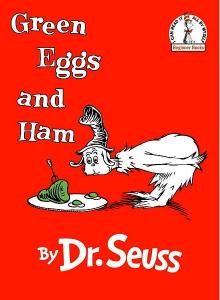 A column called A bicycle for a little girl had me thinking about its connections to children’s literature, reading and learning.
A column called A bicycle for a little girl had me thinking about its connections to children’s literature, reading and learning.“Aren’t you the little girl who is always in here looking at bikes?” Emily nodded. “Is this going to be your bike?” Again she nodded. He smiled and turned to me, “You know, the shop ain’t that busy right now. You just pay for half of them, I’ll donate the other half, and I’ll fix it up for free.”
I nodded my agreement, and Emily ran to him and gave him a big hug. The old man smiled. “I’d say a hug is darned good pay.”
I paid my part, and a few days later we took Emily to the store to pick up her bike. Her happiness when she rode it was pay enough for all of us. As we left the store, Emily turned to me. “Is Mr. Johnson one of the angels you told me about that God has here that helps people?”What kinds of children’s books with lessons are most enjoyable for young readers?
I nodded. “I’m sure he is, Emily. There are lots of them all around us.”
Emily rode her bike everywhere after that, and everyone loved her and watched out for her. One Saturday, as she ate dinner with us, she was unusually quiet. “What’s the matter, Emily?” I asked.
“You go to church every Sunday and learn about God, don’t you?” she asked. I nodded, so she continued. “Do you think God would let me come to church, too?”
“Of course He would,” I said. “Why do you ask?”
“Because I want to become an angel and help people, too,” she replied
“You don’t have to go to church to be an angel or to help people,” I said.
Here are three of my favorites:
Green Eggs & Ham by Dr. Seuss : This book is all about trying new things, when those new things seem strange or unappealing. This classic Dr. Seuss title rhythmic and lyrical and hilarious in a way that both children and adults can appreciate. Dr. Seuss argues his point by reducing the fear of trying new things to absurdity, showing what zany trials the creature in the hat will go through to avoid tasting the green eggs and ham. Ultimately, Seuss shows, in colorful terms, that there is nothing to fear but fear itself. Once we overcome our fears–of foods, people, activities–we open ourselves to new and enjoyable experiences which can bring a splash of zest to the monotony of daily life. I always enjoy getting to the very end when the main character tastes the eggs and ham.
The Berenstain Bears and the Messy Room by Stan & Jan Berenstain : ”The room shared by Brother and Sister is a mess because the cubs argue over who should neaten up instead of working together. Sure to make toddlers smile while they absorb an implied lesson,” according to Publishers Weekly. The Berenstain Bears’ books offer many lessons. This book starts with a problem (a messy room) and ends with a happy solution that the whole family works on together.
It’s Time to Start Using Your Words by Lawrence Shapiro : Young children accustomed to expressing themselves with tantrums, gestures, or simple silence need to learn that using their words is the best way to make their thoughts and feelings heard. This book helps kids learn to say ‘please’ and ‘thank you’ and express themselves in productive ways. The book is written by child psychologist Lawrence Shapiro and includes language development information and advice for parents. Reading this book at storytime is a great way to encourage your child to communicate with words and leave crying and shyness behind. The book follows several children as they do normal daily activities and encourages them to use words to express their feelings or make requests, as opposed to just pointing or crying. For years, before reading this book, I found myself saying “Please use your words…” to my young children throughout the day. It’s nice to have found a book that reinforces that concept.
Labels:
Children's Literature,
Dr. Seuss,
gaming,
Green Eggs & Ham,
Lawrence Shapiro,
Libraries,
literature,
morality,
Parenting,
Publishers Weekly,
The Berenstain Bears,
transportation,
words
A Bad Case Of Stripes: An inspiring Children’s Book with a Positive Message
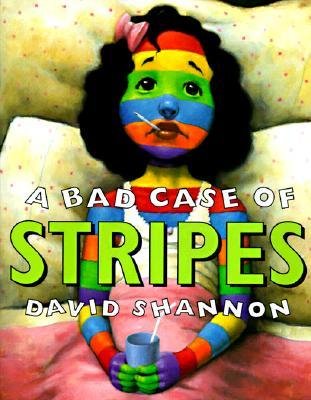 “With
technology developing at a record pace and kids mastering iPads before
they’re even out of diapers, it’s more important than ever to instill
the love of reading in our children,” writes Julie Handler, co-founder of Positively Positive:
“With
technology developing at a record pace and kids mastering iPads before
they’re even out of diapers, it’s more important than ever to instill
the love of reading in our children,” writes Julie Handler, co-founder of Positively Positive:Although it’s never too late, the importance of getting kids to develop a love for reading early on often correlates with a love for learning, a passion for lifelong reading, and so many other positive traits that ultimately lead to the empowerment needed for success.
In our home we have acquired quite the collection of literary gems — in fact, we have more books than toys. I’ve happened upon wonderful books in all kinds of random places, so I’m always on the lookout. Of course, the library is always a great option, which we frequent at least every other week — a ritual which we started before the girls could even walk. Another one of my favorite places to find amazing books is museum bookshops. You would be surprised at the treasures you may come across there.My favorite book from Handler’s list of 50 Inspiring Children’s Books with a Positive Message, is A Bad Case Of Stripes, written and illustrated by David Shannon.
Camilla Cream loves lima beans, but she never eats them. Why? Because the other kids in her school don”t like them. And Camilla Cream is very, very worried about what other people think of her. In fact, she”s so worried that she”s about to break out in… a bad case of stripes!
“On this … book’s striking dust jacket, a miserable Betty-Boop-like
girl, completely covered with bright bands of color, lies in bed with a
thermometer dangling from her mouth,” wrote one reviewer. “The
rainbow-hued victim is Camilla Cream, sent home from school after some
startling transformations: ‘when her class said the Pledge of
Allegiance, she turned red, white, and blue, and she broke out in
stars!’ Scientists and healers cannot help her, for after visits from
“an old medicine man, a guru, and even a veterinarian… she sprouted
roots and berries and crystals and feathers and a long furry tail.” The
paintings are technically superb … The doe-eyed girl changes her stripes
at anyone’s command, and only nonconformity can save her. When she
finally admits her unspeakable secret … she loves lima beans … she is
cured. Shannon (How Georgie Radbourn Saved Baseball) juggles dark humor
and an anti-peer-pressure message. As her condition worsens, Camilla
becomes monstrous, ultimately merging with the walls of her room. The
hallucinatory images are eye-popping.”
School Library Journal called it:
A highly original moral tale acquires mythic proportions when Camilla Cream worries too much about what others think of her and tries desperately to please everyone. First stripes, then stars and stripes, and finally anything anyone suggests (including tree limbs, feathers, and a tail) appear vividly all over her body. The solution: lima beans, loved by Camilla, but disdained for fear they’ll promote unpopularity with her classmates. Shannon’s exaggerated, surreal, full-color illustrations take advantage of shadow, light, and shifting perspective to show the girl’s plight. Bordered pages barely contain the energy of the artwork; close-ups emphasize the remarkable characters that inhabit the tale. Sly humor lurks in the pictures, too. For example, in one double-page spread the Creams are besieged by the media including a crew from station WCKO. Despite probing by doctors and experts, it takes “an old woman who was just as plump and sweet as a strawberry” to help Camilla discover her true colors. Set in middle-class America, this very funny tale speaks to the challenge many kids face in choosing to act independently.
Shannon’s over-the-top art is sensational, an ingenious combination
of the concrete and the fantastic that delivers more than enough punch
to make up for the somewhat heavy hand behind the story, and as usual,
his wonderfully stereotypic characters are unforgettable. The pictures
are probably enough to attract young browsers (Camilla in brilliant
stripped glory graces the jacket), and the book’s irony and wealth of
detail may even interest readers in higher grades.
Booklist said:Camilla, who loves lima beans but won’t eat them because it’s not cool, finds that deferring to others isn’t all it’s cracked up to be. In fact, her desire to please and be popular causes her some spectacular problems: she suddenly breaks out in stripes, then stars, then turns “purple polka-dotty” at the behest of a delighted classmate. Her weird mutations, which stymie doctors and send the media into a frenzy, become more and more extreme until she finally blends into the walls of her room–her lips the red-blanketed mattress on her bed, her eyes the paintings on the wall. Will she never be herself again? Shannon’s over-the-top art is sensational, an ingenious combination of the concrete and the fantastic that delivers more than enough punch to make up for the somewhat heavy hand behind the story, and as usual, his wonderfully stereotypic characters are unforgettable. The pictures are probably enough to attract young browsers (Camilla in brilliant stripped glory graces the jacket), and the book’s irony and wealth of detail may even interest readers in higher grades. Try this for leading into a discussion on being different.
Teaching Young Adults About Communism
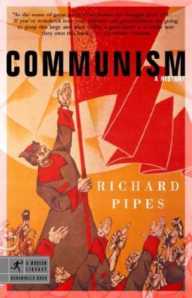 What are some resources for teaching kids about Communism?
What are some resources for teaching kids about Communism?How can we help them understand this phenomenon, which is often referenced in newspaper columns, on television and other popular media?
For example, “May Day, celebrated on May 1, has a storied history that goes back to pre-Christian times celebrating Flora, the Roman goddess of flowers, and later on as the first day of summer, writes Richard Larson in the Idaho State Journal. “It was in essence, an innocuous pantheistic celebration of the old aphorism of ‘April showers bring May flowers,’ celebrated in different ways around the world.”
That tradition changed dramatically however, after the 1886 Haymarket Affair in Chicago. In synoptic terms, what started as a peaceful gathering in support of striking workers on Tuesday May 4, 1886, ended as a violent precursor to leftist destructive demonstrations. As police attempted to disperse the crowd, someone threw a bomb at police. The blast, and subsequent gunfire, resulted in the deaths of seven police officers, four civilians, and numerous injuries. Investigations led to eight anarchists convicted of conspiracy, with seven of those sentenced to death for their involvement.
The Second International, also known as Socialist International, memorialized the events of the Haymarket Affair by declaring May Day, or May First, an international labor and socialist holiday. Thus, International Worker’s Day became May Day, a celebration of labor and socialism. The significance of this historical connection between ideologically aligned entities cannot be overstated.
Consequently, May Day has become an excuse for labor, socialist, communist, and anarchist groups to demonstrate, destroy property, occupy parks, and denounce capitalism, free enterprise, and America’s founding principles. This may seem inconsequential history, but it establishes the core ideological alliance of political elements whose objectives remain inextricably intertwined in contemporary American politics.One of my favorite books for high schoolers is Communism: A History (Modern Library Chronicles) by Richard Pipes. With astonishing authority and clarity, Pipes has fused a lifetime’s scholarship into a single focused history of Communism, from its hopeful birth as a theory to its miserable death as a practice. At its heart, the book is a history of the Soviet Union, the most comprehensive reorganization of human society ever attempted by a nation-state. This is the story of how the agitation of , two mid-stratenineteenth-century European thinkers and writers, led to a great and terrible world religion that brought down a mighty empire, consumed the world in conflict, and left in its wake a devastation whose full costs can only now be tabulated.
The book is strategically short. Not a word is wasted in its mere 194 pages. Teachers and parents can engage young people with this text because it is very enjoyable and easy to read, yet dense with insight.
Labels:
april showers bring may flowers,
communism,
Friedrich Engels,
haymarket affair,
History,
Idaho State Journal,
Karl Marx,
libya,
May Day,
Non Fiction,
politics,
Rick Larsen,
Young Adult
Young Journalist’s Book: How to Write and Produce Your Own Newspaper
CBS anchor Scott Pelley said at a speech at Quinnipiac University
that journalists “are getting big stories wrong, over and over again,”
as quoted by a commenter on The Idaho State Journal politics blog.
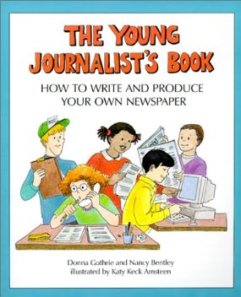 Young Journalist’s Book: How to Write and Produce Your Own Newspaper, is a great place to help children begin learn the difference between good and bad journalism.
Young Journalist’s Book: How to Write and Produce Your Own Newspaper, is a great place to help children begin learn the difference between good and bad journalism.
 Young Journalist’s Book: How to Write and Produce Your Own Newspaper, is a great place to help children begin learn the difference between good and bad journalism.
Young Journalist’s Book: How to Write and Produce Your Own Newspaper, is a great place to help children begin learn the difference between good and bad journalism.The book is a step-by-step guide that explains what a journalist does, what makes an interesting story, and how newspapers differ from books. Students learn about gathering facts, writing a story, proofreading, designing layout, printing, and distributing their newspaper. There are frequent references to using computers in the process. The authors describe the different types of stories, e.g., news, features, and editorials, with hints on how to write each one and suggestions for topics. This title is similar in format to Guthrie and Bentley’s The Young Author’s Do-It Yourself Book (1994) and The Young Producer’s Video Book (1995, both Millbrook). The full-color cartoons are appealing. Inspirational, practical fare for writers and would-be reporters.-Marion F. Gallivan, Gannon University, Erie, PAE How talks about the steps to establishing a newspaper at your elementary school. They include:
Brainstorm possible newspaper names and story ideas with your newspaper staff. Articles can be about school-wide news, book reviews, movie reviews and more.
Assign articles to your students. Warn them about the dangers of plagiarism and explain the term to your students. Provide them with a deadline for their articles. Make the deadline reasonable. Since they are elementary school students, they will probably need at least a couple of weeks to complete their articles.
Decide whether you will type the articles into a word processing document or whether you will leave this task up to your staff. Some students know how to type quickly while others haven’t learned keyboarding yet. Be sure you run spell check and proofread the articles.
Labels:
aviation,
Children's Literature,
Creative Writing,
education,
Idaho State Journal,
journalism,
literature,
media,
newspapers,
politics,
Quinnipiac University,
research,
science,
writing
Pocatello School Demonstrates Keys for Better Reading and Writing
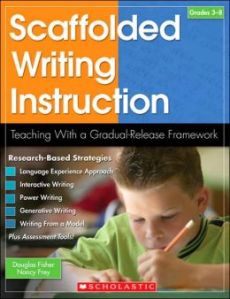 This is a repost of an article I wrote in 2006 that appeared in the Idaho State Journal.
This is a repost of an article I wrote in 2006 that appeared in the Idaho State Journal.
I was recently inspired by a day of substitute teaching at the
Pocatello Community Charter School. That morning in the parking lot, I
ran into Marjanna Hulet, one of the school’s founders, as I made my way
to the office.
__
What are you doing here? she said. Marjanna, who visits the school regularly, is demonstrating the spirit of inquiry this sunny morning, I thought to myself.
After a tour of the facility for myself, my wife, and our daughters, my thinking moved toward the elements that make popular schools like this one so beneficial for children.
I was recently inspired by a day of substitute teaching at the Pocatello Community Charter School. That morning in the parking lot, I ran into Marjanna Hulet, one of the school’s founders, as I made my way to the office.
-
What are you doing here? she said. Marjanna, who visits the school regularly, is demonstrating the spirit of inquiry this sunny morning, I thought to myself. After a tour of the facility for myself, my wife, and our daughters, my thinking moved toward the elements that make popular schools like this one so beneficial for children. What is the single most important approach to teaching that makes a difference in how well learners succeed? In the book “Classroom Discourse: The Language of Teaching and Learning,” Courtney Cazden defines this key strategy as scaffolded instruction.
-
Scaffolding, she says, is the process in which the learner participates in the full performance of a given activity to the degree to which he or she is capable. The adult provides the “helping hand.” As the learner gains competence, the teacher gradually increases expectations of how much of the full performance the child can be responsible for. When teachers scaffold students’ learning, they begin by exposing children to the task through modeling and providing examples. Gradually, students are invited to take part in the process although minimally at first. Students may work with partners or in small groups as they take more and more responsibility for the task. They are helped to solve problems and to focus on specific strategies related to what they are learning while gaining competence in the task.
Gradually, they move toward independence, applying what they know to similar but new situations. With independence, students are guided to think and talk about what they are now able to do.
Below is a summary of the process of applying strategic scaffolding to writing in a particular form, such as a memoir or poetry. At the Pocatello Community Charter School, I was able to participate in Whitney Griggs’ early elementary multiage classroom, where we engaged students in many similar strategies, from writing together to writing alone.
Griggs began with Immersion and then Exploration. During Immersion, students are exposed to the forms under study as they listen and respond to examples read aloud and share examples they discover on their own. Throughout the sharing, students are encouraged to notice patterns and similarities and to decide what makes this particular form unique.
They observe, reflect, and discuss. This exploration of the form helps students crystallize their ideas. Experimentation begins with the teacher modeling the form as a “think aloud” demonstration for the children. During a think-aloud, the teacher actually writes while saying aloud everything that is going on inside his or her head: “I think I’ll choose rain as my topic. When I think of rain, I think of wet, soggy, shiny. It cleans the streets,” and so on. The teacher generates ideas, organizes and changes them out loud as if the children were not present.
Think alouds are useful because they provide a window into how a skilled writer thinks and what the teacher is eventually going to ask students to do on their own.
“We strive to create a culture of quality at the Pocatello Community Charter School,” said Dr. Martha B. Martin, the school’s dean. “Since we have a portfolio assessment system at this school, we have a lot of conversations about ‘portfolio quality.’ Our crew leaders have to teach children what quality is, and we do this through modeling and the use of exemplars.”
“Students begin to understand that if they are going to do something, they should do it well,” Martin continued. “They begin to recognize signs of quality in their own work and that of their classmates. When you create a culture of quality at school, members of that learning community are able to critique each other’s work and help one another revise and edit. The process is slow, messy and cumbersome, but the result is portfolio quality products that help children understand what they are truly capable of creating.”
Writing articles like this one helps me to reflect and analyze inquiries such as Marjanna Hulet’s “what are you doing here?” at the Pocatello Community Charter School. There, I am experiencing the thrill of teaching and learning in an atmosphere that is truly empowering for young people.
__
What are you doing here? she said. Marjanna, who visits the school regularly, is demonstrating the spirit of inquiry this sunny morning, I thought to myself.
After a tour of the facility for myself, my wife, and our daughters, my thinking moved toward the elements that make popular schools like this one so beneficial for children.
I was recently inspired by a day of substitute teaching at the Pocatello Community Charter School. That morning in the parking lot, I ran into Marjanna Hulet, one of the school’s founders, as I made my way to the office.
-
What are you doing here? she said. Marjanna, who visits the school regularly, is demonstrating the spirit of inquiry this sunny morning, I thought to myself. After a tour of the facility for myself, my wife, and our daughters, my thinking moved toward the elements that make popular schools like this one so beneficial for children. What is the single most important approach to teaching that makes a difference in how well learners succeed? In the book “Classroom Discourse: The Language of Teaching and Learning,” Courtney Cazden defines this key strategy as scaffolded instruction.
-
Scaffolding, she says, is the process in which the learner participates in the full performance of a given activity to the degree to which he or she is capable. The adult provides the “helping hand.” As the learner gains competence, the teacher gradually increases expectations of how much of the full performance the child can be responsible for. When teachers scaffold students’ learning, they begin by exposing children to the task through modeling and providing examples. Gradually, students are invited to take part in the process although minimally at first. Students may work with partners or in small groups as they take more and more responsibility for the task. They are helped to solve problems and to focus on specific strategies related to what they are learning while gaining competence in the task.
Gradually, they move toward independence, applying what they know to similar but new situations. With independence, students are guided to think and talk about what they are now able to do.
Below is a summary of the process of applying strategic scaffolding to writing in a particular form, such as a memoir or poetry. At the Pocatello Community Charter School, I was able to participate in Whitney Griggs’ early elementary multiage classroom, where we engaged students in many similar strategies, from writing together to writing alone.
Griggs began with Immersion and then Exploration. During Immersion, students are exposed to the forms under study as they listen and respond to examples read aloud and share examples they discover on their own. Throughout the sharing, students are encouraged to notice patterns and similarities and to decide what makes this particular form unique.
They observe, reflect, and discuss. This exploration of the form helps students crystallize their ideas. Experimentation begins with the teacher modeling the form as a “think aloud” demonstration for the children. During a think-aloud, the teacher actually writes while saying aloud everything that is going on inside his or her head: “I think I’ll choose rain as my topic. When I think of rain, I think of wet, soggy, shiny. It cleans the streets,” and so on. The teacher generates ideas, organizes and changes them out loud as if the children were not present.
Think alouds are useful because they provide a window into how a skilled writer thinks and what the teacher is eventually going to ask students to do on their own.
“We strive to create a culture of quality at the Pocatello Community Charter School,” said Dr. Martha B. Martin, the school’s dean. “Since we have a portfolio assessment system at this school, we have a lot of conversations about ‘portfolio quality.’ Our crew leaders have to teach children what quality is, and we do this through modeling and the use of exemplars.”
“Students begin to understand that if they are going to do something, they should do it well,” Martin continued. “They begin to recognize signs of quality in their own work and that of their classmates. When you create a culture of quality at school, members of that learning community are able to critique each other’s work and help one another revise and edit. The process is slow, messy and cumbersome, but the result is portfolio quality products that help children understand what they are truly capable of creating.”
Writing articles like this one helps me to reflect and analyze inquiries such as Marjanna Hulet’s “what are you doing here?” at the Pocatello Community Charter School. There, I am experiencing the thrill of teaching and learning in an atmosphere that is truly empowering for young people.
Finding Joy in the The Pythagorean Theorem
Read this article on Daily Kos from Mar. 18 2012
Read this article on the Idaho Press Tribune website from Mar. 22, 2012
Read this article on Yahoo! from March 26, 2012
Pythagorean Theorem may be the best-known equation in mathematics. Its origins reach back to the beginnings of civilization, and today every student continues to study it. What most nonmathematicians don’t understand or appreciate is why this simply stated theorem has fascinated countless generations.
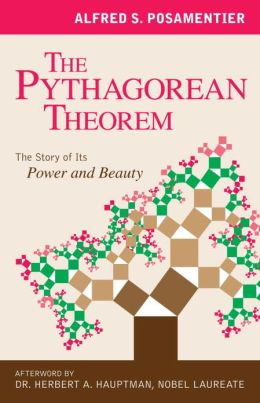 I first met Alfred S. Posamentier in
2001, when he was the Dean of Education at City College in New York.
The energy level of his intellectual engagement with my work is part of
an experience I will never forget.
I first met Alfred S. Posamentier in
2001, when he was the Dean of Education at City College in New York.
The energy level of his intellectual engagement with my work is part of
an experience I will never forget.
In his entertaining and informative book, The Pythagorean Theorem: The Story of Its Power and Beauty , Posamentier, a veteran math educator, makes the importance of the Pythagorean theorem delightfully clear.
The Pythagorean theorem has attracted interest outside mathematics as a symbol of mathematical abstruseness, mystique, or intellectual power. Scores of references to it can be found in literature, plays, musicals, songs, stamps and cartoons. It can be introduced to students during the middle school years and becomes increasingly important during high school. It is not enough to merely state the algebraic formula for the Pythagorean Theorem.
According to University of Georgia graduate student Stephanie Morris:
Students need to see the geometric connections as well. The teaching and learning of the Pythagorean Theorem can be enriched and enhanced through the use of dot paper, geoboards, paper folding, and computer technology, as well as many other instructional materials.
The Pythagorean theorem or Pythagoras’ theorem is a relation in Euclidean geometry among the three sides of a right triangle (right-angled triangle). In terms of areas, it states:
In any right triangle, the area of the square whose side is the hypotenuse (the side opposite the right angle) is equal to the sum of the areas of the squares whose sides are the two legs (the two sides that meet at a right angle).
The theorem can be written as an equation relating the lengths of the sides a, b and c, often called the Pythagorean equation: a^2 + b^2 = c^2\!\, where c represents the length of the hypotenuse, and a and b represent the lengths of the other two sides.
The theorem is named after the Greek mathematician Pythagoras, who by tradition (only) is credited with its discovery and proof. The theorem has numerous proofs, possibly the most of any mathematical theorem. These are very diverse, including both geometric proofs and algebraic proofs, with some dating back
thousands of years. The theorem can be generalized in various ways, including higher-dimensional spaces, to spaces that are not Euclidean, to objects that are not right triangles, and indeed, to objects that are not triangles at all, but n-dimensional solids.
Posamentier begins his book with a brief history of Pythagoras and the early use of his theorem by the ancient Egyptians, Babylonians, Indians, and Chinese, who used it intuitively long before Pythagoras’s name was attached to it.
He then shows the many ingenious ways in which the theorem has been proved visually using highly imaginative diagrams. Some of these go back to ancient mathematicians; others are comparatively recent proofs, including one by the twentieth president of the United States, James A. Garfield.
After demonstrating some curious applications of the theorem, Posamentier then explores the Pythagorean triples, pointing out the many hidden surprises of the three numbers that can represent the sides of the right triangle (e.g, 3, 4, 5 and 5, 12, 13). And many will truly amaze the reader.
Next, Posamentier turns to the “Pythagorean means” (the arithmetic, geometric, and harmonic means). By comparing their magnitudes in a variety of ways, he gives the reader a true appreciation for these mathematical concepts.
The final two chapters view the Pythagorean theorem from an artistic point of view–namely, how Pythagoras’s work manifests itself in music and how the Pythagorean theorem can influence fractals.
This lucid presentation and gift for conveying the significance of this key equation to those with little math background will inform, entertain, and inspire the reader, once again demonstrating the power and beauty of mathematics!
Read this article on the Idaho Press Tribune website from Mar. 22, 2012
Read this article on Yahoo! from March 26, 2012
Pythagorean Theorem may be the best-known equation in mathematics. Its origins reach back to the beginnings of civilization, and today every student continues to study it. What most nonmathematicians don’t understand or appreciate is why this simply stated theorem has fascinated countless generations.
 I first met Alfred S. Posamentier in
2001, when he was the Dean of Education at City College in New York.
The energy level of his intellectual engagement with my work is part of
an experience I will never forget.
I first met Alfred S. Posamentier in
2001, when he was the Dean of Education at City College in New York.
The energy level of his intellectual engagement with my work is part of
an experience I will never forget.In his entertaining and informative book, The Pythagorean Theorem: The Story of Its Power and Beauty , Posamentier, a veteran math educator, makes the importance of the Pythagorean theorem delightfully clear.
The Pythagorean theorem has attracted interest outside mathematics as a symbol of mathematical abstruseness, mystique, or intellectual power. Scores of references to it can be found in literature, plays, musicals, songs, stamps and cartoons. It can be introduced to students during the middle school years and becomes increasingly important during high school. It is not enough to merely state the algebraic formula for the Pythagorean Theorem.
According to University of Georgia graduate student Stephanie Morris:
Students need to see the geometric connections as well. The teaching and learning of the Pythagorean Theorem can be enriched and enhanced through the use of dot paper, geoboards, paper folding, and computer technology, as well as many other instructional materials.
The Pythagorean theorem or Pythagoras’ theorem is a relation in Euclidean geometry among the three sides of a right triangle (right-angled triangle). In terms of areas, it states:
In any right triangle, the area of the square whose side is the hypotenuse (the side opposite the right angle) is equal to the sum of the areas of the squares whose sides are the two legs (the two sides that meet at a right angle).
The theorem can be written as an equation relating the lengths of the sides a, b and c, often called the Pythagorean equation: a^2 + b^2 = c^2\!\, where c represents the length of the hypotenuse, and a and b represent the lengths of the other two sides.
The theorem is named after the Greek mathematician Pythagoras, who by tradition (only) is credited with its discovery and proof. The theorem has numerous proofs, possibly the most of any mathematical theorem. These are very diverse, including both geometric proofs and algebraic proofs, with some dating back
thousands of years. The theorem can be generalized in various ways, including higher-dimensional spaces, to spaces that are not Euclidean, to objects that are not right triangles, and indeed, to objects that are not triangles at all, but n-dimensional solids.
Posamentier begins his book with a brief history of Pythagoras and the early use of his theorem by the ancient Egyptians, Babylonians, Indians, and Chinese, who used it intuitively long before Pythagoras’s name was attached to it.
He then shows the many ingenious ways in which the theorem has been proved visually using highly imaginative diagrams. Some of these go back to ancient mathematicians; others are comparatively recent proofs, including one by the twentieth president of the United States, James A. Garfield.
After demonstrating some curious applications of the theorem, Posamentier then explores the Pythagorean triples, pointing out the many hidden surprises of the three numbers that can represent the sides of the right triangle (e.g, 3, 4, 5 and 5, 12, 13). And many will truly amaze the reader.
Next, Posamentier turns to the “Pythagorean means” (the arithmetic, geometric, and harmonic means). By comparing their magnitudes in a variety of ways, he gives the reader a true appreciation for these mathematical concepts.
The final two chapters view the Pythagorean theorem from an artistic point of view–namely, how Pythagoras’s work manifests itself in music and how the Pythagorean theorem can influence fractals.
This lucid presentation and gift for conveying the significance of this key equation to those with little math background will inform, entertain, and inspire the reader, once again demonstrating the power and beauty of mathematics!
A Model School: Coyote Ridge Elementary
This is a repost of an article originally published in The Post Register in July 2006.
“My author visits in the Roseville/Antelope area were most enjoyable.”
—
Teachers need to model effective learning behaviors. Students examine the instructor, then learn and grow through reflection, imitation, and interpretation. As with human beings, schools also can be held up as role models.
Since the ideas presented in my last TalkBack, about school newsletters, prompted numerous responses from grateful and concerned educators wanting to hear more, I’ve decided to highlight a model school. The goal here is to enhance the many good practices that are already being implemented inlocal classrooms.
Coyote Ridge Elementary is one of California’s Distinguised Schools. I worked closely with it’s principal, Michelle Harmeier, a few years ago while performing author visits in the Dry Creek Joint Elementary District. The district lies in the suburban Roseville/Antelope area of northern SacramentoCounty, and southern Placer County.
Coyote Ridge is a school with a vision. Strong partnerships between students, parents, staff, and the community enrich the core curriculum program.
Program highlights for last school year include: improving academic achievement in the areas of English/Language Arts and Math; enhancing co- curricular and enrichment programs; building assets in students and staff; and implementing an Accelerated Reader program.
The district’s web site includes a School Calendar, a , an Accelerated Reader Book List, and an Accelerated Reader Book Level List, for Coyote Ridge Elementary.
My author visits in the Roseville/Antelope area were most enjoyable. Harmeier acted as a liason for four schools, and I visited one each day. The students engaged in whole group readings and Q & A sessions with me, followed by breakouts with small groups in the different grades. In the individual classrooms, I heard and critiqued student creative writing. After I left, teachers had me interact with different classes as students wrote in questions and posted their material on my children’s literature and literacy website.
Such author visits, literature studies, and book discussions can be used to help students deepen their understanding of their own cultural backgrounds, as they connect to the backgrounds of others. Students and their families learn that people like themselves are found in print. Making sense of print takes on a new dimension for all involved.
Such partnerships are also going on in Idaho Falls. Brian Arave, Director Community and Foundation Relations for School District 91, deserves special thanks for his enthusiastic outreach. My family looks forward to many more meaningful experiences as the school year begins.
“My author visits in the Roseville/Antelope area were most enjoyable.”
—
Teachers need to model effective learning behaviors. Students examine the instructor, then learn and grow through reflection, imitation, and interpretation. As with human beings, schools also can be held up as role models.
Since the ideas presented in my last TalkBack, about school newsletters, prompted numerous responses from grateful and concerned educators wanting to hear more, I’ve decided to highlight a model school. The goal here is to enhance the many good practices that are already being implemented inlocal classrooms.
Coyote Ridge Elementary is one of California’s Distinguised Schools. I worked closely with it’s principal, Michelle Harmeier, a few years ago while performing author visits in the Dry Creek Joint Elementary District. The district lies in the suburban Roseville/Antelope area of northern SacramentoCounty, and southern Placer County.
Coyote Ridge is a school with a vision. Strong partnerships between students, parents, staff, and the community enrich the core curriculum program.
Program highlights for last school year include: improving academic achievement in the areas of English/Language Arts and Math; enhancing co- curricular and enrichment programs; building assets in students and staff; and implementing an Accelerated Reader program.
Reading practice quizzes are the foundation of the Accelerated Reader program. They help teachers measure students’ comprehension of books they read independently, with an adult, or have read to them. The objective of this program is to help teachers motivate and monitor reading practice. They ensure a successful, positive experience if the student has read a book at the proper reading level.What Effective Schools Do is designed as guide to assist educators with activities for implementing a continuous school improvement system through application of the seven correlates of effective schools: 1. High expectations for success 2. Strong instructional leadership 3. A clear and focused mission 4. Opportunity to learn/time on task 5. Frequent monitoring of student progress 6. Safe and orderly environment 7. Positive home-school relations The ten chapters provide a comprehensive description of practices that enable educators to build and sustain a school culture that accommodates the learning expectations and needs of all students. The correlates of effective schools represent the knowledge educators need to successfully teach all children. Taken together, the correlates are more than just theory; they are what effective schools do.
The district’s web site includes a School Calendar, a , an Accelerated Reader Book List, and an Accelerated Reader Book Level List, for Coyote Ridge Elementary.
My author visits in the Roseville/Antelope area were most enjoyable. Harmeier acted as a liason for four schools, and I visited one each day. The students engaged in whole group readings and Q & A sessions with me, followed by breakouts with small groups in the different grades. In the individual classrooms, I heard and critiqued student creative writing. After I left, teachers had me interact with different classes as students wrote in questions and posted their material on my children’s literature and literacy website.
Such author visits, literature studies, and book discussions can be used to help students deepen their understanding of their own cultural backgrounds, as they connect to the backgrounds of others. Students and their families learn that people like themselves are found in print. Making sense of print takes on a new dimension for all involved.
Such partnerships are also going on in Idaho Falls. Brian Arave, Director Community and Foundation Relations for School District 91, deserves special thanks for his enthusiastic outreach. My family looks forward to many more meaningful experiences as the school year begins.
THE MIGHTY LALOUCHE: A charming tale by Matthew Olshan that holds a few surprises between its pages
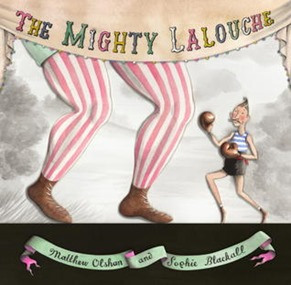 One
hundred and a few-odd years ago, in Paris, France, there lived a humble
postman named Lalouche. He was small, but his hands were nimble, his
legs were fast, and his arms were strong. In THE MIGHTY LALOUCHE, the extraordinary happens when Monsieur Lalouche takes to the ring and proves himself a boxer extraordinaire. “C’est impossible!” you say? This charming tale by Matthew Olshan, illustrated by New York Times Best Illustrated Award winner Sophie Blackall, holds a few surprises between its pages.
One
hundred and a few-odd years ago, in Paris, France, there lived a humble
postman named Lalouche. He was small, but his hands were nimble, his
legs were fast, and his arms were strong. In THE MIGHTY LALOUCHE, the extraordinary happens when Monsieur Lalouche takes to the ring and proves himself a boxer extraordinaire. “C’est impossible!” you say? This charming tale by Matthew Olshan, illustrated by New York Times Best Illustrated Award winner Sophie Blackall, holds a few surprises between its pages.
__
Lalouche is an endearingly oddball hero, and Blackall takes her always-exquisite
ink-and-watercolor artwork to another level. . . . C’est formidable!”
—Publishers Weekly, Starred
When
his job is replaced by an electric car, the postman Lalouche turns to
boxing to support himself and his pet finch, Genevieve. But—“You? A
boxer?” the fighters ask. “I could sneeze and knock you down!” Still,
Lalouche refuses to give up. Weathering such threats as “I’ll zap him,”
“I’ll tie him in a pretty bow,” and, most alarmingly, “I’ll squeeze him till he pops!” Lalouche nimbly thwarts each of his frightening foes in the ring, proving that size is no indicator of strength or will.
This
marvelous story, full of humor and heart, salutes the unlikely
champions who remind young readers that creativity and wit trump brute
force. As the plot unfolds in Paris, France, in the early 1900s, readers
are treated to historical details, heightened by Blackall’s clever,
kid-friendly art. In keeping with the historical nature of the story,
Blackall uses the nearly forgotten Japanese paper diorama art style
called tatebanko for this book to stunning effect.
__
“The illustrations are outstanding–Blackall has outdone herself. . . .
The text and pictures work expertly together.”
—School Library Journal, Starred
was
written specifically for Sophie Blackall after Matthew Olshan
discovered that she collected old pictures of boxers, especially
“extremely skinny ones with big billowing boxing trunks.”
MATTHEW OLSHAN is the author of Finn: A Novel, a modern telling of Mark Twain’s The Adventures of Huckleberry Finn, with girls as protagonists rather than boys. His latest novel, The Flown Sky,
is a fantasy in the tradition of C. S. Lewis’s Narnia Chronicles.
Olshan lives in Baltimore, but also has a little farm in south central
Pennsylvania, called Pencil Creek.
SOPHIE BLACKALL received the New York Times Best Illustrated Award for her book Big Red Lollipop, and won the Ezra Jack Keats Award for New Talent. She is the illustrator of Meet Wild Boars, a Bulletin Blue Ribbon Book; Jumpy Jack & Googily; What’s So Bad About Being an Only Child?; Summer Is Summer; Edwin Speaks Up; and others. A native of Australia, she lives in Brooklyn, New York.
Made Me a Story … Still Got It
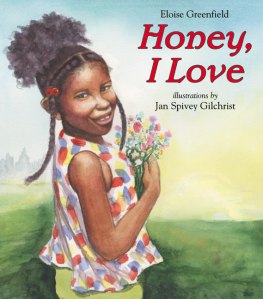 When I am working with children in schools, I always remind them that one of the great things about writing is that it always stays with you.
When I am working with children in schools, I always remind them that one of the great things about writing is that it always stays with you.The poem Things by Eloise Greenfied summarizes the feeling:
It includes the words:
Bought me some candy …
Ain’t got it no more
… Made me a poem
Still got it
Click here for the full text of the poem.
So what a joy it was to find this heartwarming story that I wrote back in 1992 when I was working as a reporter for The Morning Call in Allentown, PA.
Ten wheelchair-bound people last night were rolled up a closed-off St. John Street on their way to hear songs, jokes and words of inspiration at a service that honored three people who had made a major contribution to bettering their lives. The procession went from Good Shepherd to Grace Lutheran Church of Allentown.
The Rev. Daniel G. Gambet, president of Allentown College of St. Francis de Sales, quoted Mother Theresa, saying, “Electric wire is useless unless the current passes through it and lights up the world,” at the seventh annual Raker Memorial Award Service, named for the founders of Good Shepherd. … Gilbert E. Castree, a 78-year-old resident of Allentown, said his 15 years as a member of Good Shepherd’s board of trustees have been the best of his life. Stricken with polio, meningitis and pneumonia all at age 9, Castree gave testimony to the human spirit by going from being handicapped to playing high school football.Read: Good Shepherd Bestows Honors On Three Who Made Difference
“The feeling you get volunteering here is unlike the feeling you get anywhere else,” Castree said. “The many years have meant more to me than I could ever express.”
Hat Tip to The Morning Call for keeping their archives public, going back so many years.
And I remind young learners that “even when archives are no longer there, your story always is.”
___
See this recent related article on the topic of faith in the public square, from the Idaho State Journal.
How interactive technology is changing the classroom and our children
If you walk into most classrooms in the UK today, you will soon notice the big screen in the middle of the room at the front.
It’s not a television or movie screen, but an interactive whiteboard, and it can be used for many activities within the classroom enabling the teachers and students to present, share, interact and most importantly collaborate with each other. The board itself connects to a computer and a projector, displaying whatever is on the computer screen.
When this technology first appeared in the UK in the late 1990′s it was referred to as an electronic blackboard, and, at a very low level, some are still used in this way.
Read the full story.
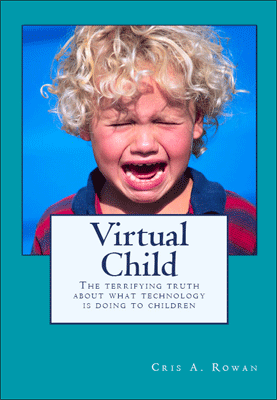 Here is an alternative viewpoint: Virtual Child: The terrifying truth about what technology is doing to children
Here is an alternative viewpoint: Virtual Child: The terrifying truth about what technology is doing to childrenChildren now use an average 8 hours per day of entertainment technology with profound impact on their physical, mental, social and academic development. One third of North American children enter school developmentally delayed, and child obesity is now a national epidemic. One in six children has a diagnosed mental illness, with child aggression and unmanageable behaviour increasingly the norm. One in six children cannot pay attention and require learning assistance. With research now showing causal links between physical, mental, social and academic disorders in children who overuse technology, schools and homes continue to escalate unrestricted use. Virtual Child offers parents, health and education professionals innovative tools and techniques to enhance child development and academic performance, while managing balanced use of technology. Modifications to home and school structure and environment, serve to ensure that every new millennium child will achieve a healthy, productive and sustainable future.
Author Chris Rowan is a frequent guest on CBC public radio and featured on CBC TV’s Doc Zone, Cris Rowan is known world-wide as a child development expert in the area of technology’s effects on children. As CEO of Zone’in Programs Inc. Cris Rowan has developed a ‘System of Solutions’ to address the issues of technology overuse by children. Zone’in Products, Workshops, Training and Consultation services are widely used and respected by parents, as well as health and education professionals in health units, child development centers, schools, clinic and hospital based settings. Zone’in Products include Zone’in, Move’in, Unplug’in and Live’in educational programs to enhance child health and academic performance. Zone’in Foundation Series Workshop topics include sensory processing, motor development, attachment and addictions, technology overuse, attention and learning, productivity school design, and early intervention. Zone’in Training certifies pediatric occupational therapists as Foundation Series Workshop instructors. Zone’in Consultation services provide education and training to promote Balanced Technology Management initiatives in home, school and community settings.
Rowan recently developed the Balanced Technology Management (BTM) concept which promotes managing balance between activities children need for growth and success with technology use, and has created BTM initiatives for six target groups: parents, teachers, health professionals, government, researchers and technology production corporations.
Rowan is a prolific writer and has published numerous articles on sensory and motor development, printing literacy, attachment, addictions, attention, learning, and the impact of technology on child development. Rowan authors a monthly Development Series newsletter with a readership of over 40,000 parents, health and education professionals. Rowan has authored the following policy initiatives Unplug – Don’t Drug: Routine Technology Screening Prior to Behavior Diagnosis and Medication, Schools Operating Safely – Child Behavior Management Policy and Procedures, Creating Sustainable Futures for Children of the New Millennium, and Linking Corporations to Communities – Technology Production Corporate Funding Opportunities for Schools and Communities.
Related Reading: The iQRite Touch Frame is the world’s first kitset touch frame designed for a wide range of applications and any surface or digital display technology.
BEAN DOG & NUGGET: Charise Mericle Harper Cooks Up Another Great Book Idea
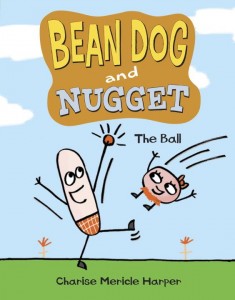 This is an excerpt from an excellent blog entry by Charise Mericle Harper.
This is an excerpt from an excellent blog entry by Charise Mericle Harper.The other day I was at my son’s book fair, talking with his teacher. A few of my books were included in the event, and she picked one up and flipped through it. All of a sudden she asked, “Where do you get your ideas?” I’m pretty good at answering this question at school talks, but on the spot, I was speechless. I ended up smiling uncomfortably, shrugging my shoulders and saying, “I don’t know,” and then I quickly changed the subject.
On stage and in front of a group, I’m fine with the spotlight, but in a social situation, the last thing I’m comfortable talking about is me. Later that day, I started feeling guilty about how I’d responded. I should have made more of an effort to answer her, because her question was a good one. In fact, it was the exact same question I always want to ask other authors and illustrators. It’s why I’m always excited to meet them. I want to know: How do you do that thing that you do? Where do you get your ideas? And how do you get those ideas to swirl together perfectly so you can use them?Read the full text of: BEAN DOG & NUGGET: Charise Mericle Harper Cooks Up Another Great Book Idea
Using simple text and cartoon-style illustrations, Charise Mericle Harper introduces young readers to a new graphic novel series, Bean Dog and Nugget.These two engaging characters capture young kids’ actions, reactions, conversations, imagination, and humor with spot-on accuracy. Kids will want to follow Bean Dog and Nugget and their adventures in each and every book in the series.
In The Ball, Bean Dog and Nugget lose Bean Dog’s shiny new ball in a bush. They dream up elaborate and silly ways to get it back while they argue about who is actually going to go and get it. Enter Superdog and Ninja Nugget for a hilarious ending that kids will love and relate to.
CHARISE MERICLE HARPER has written and illustrated numerous children’s books, including Just Grace; Wedgieman: A Hero Is Born; Wedgieman to the Rescue; The Power of Cute; Gigi in the Big City; Milo’s Special Words; Good Night, Leo; Pink Me Up; When Randolph Turned Rotten; Fashion Kitty; and Fashion Kitty Versus the Fashion Queen. She lives in Mamaroneck, New York, with her husband and their two children. Charise loves creating art and stories, petting her cat, drinking coffee, and eating pie.
Bebop Books: Common Core Now Supported
 This
comprehensive literacy program includes resources for guided reading,
classroom libraries, shared reading, assessment and ESL/Dual Language
programs. Explore our site to learn more about how Bebop Books can help
your children succeed in their reading efforts.
This
comprehensive literacy program includes resources for guided reading,
classroom libraries, shared reading, assessment and ESL/Dual Language
programs. Explore our site to learn more about how Bebop Books can help
your children succeed in their reading efforts.Read this article by Jeanne Clidas, Ph.D.
Common Core State Standards
Our Bebop titles support the new K-5 Common Core State Standards. For every title, rigorous, reading-level appropriate decoding and comprehension questions for both Literature and Informational Text have been provided, targeting:
- Key Ideas and Details
- Craft and Structure
- Integration of Knowledge and Ideas
- Range of Reading and Level of Text Complexity
Guided Reading
Bebop Books are carefully leveled texts that appeal to children’s interests and provide the supports they need as they face challenges in their development as readers. All books are leveled by the most common book leveling systems used by teachers ensuring appropriate matches between children and books. Our titles cover a wide range of concepts, themes, and interest areas that appeal to children and fit right into your daily reading block.
Perfect for small groups, Bebop Books include leveled sets that meet the needs of your emergent readers and comprehensive lesson plans to guide your instruction. Our literacy materials provide opportunities in guided practice, scaffolded learning, independent sustained reading, and comprehension applications. In addition, all books contain text features that support emergent reader strategies, skills, and behaviors such as:
- Topics familiar to children
- High-frequency words, sight words and decodable words
- Simple patterns and a clear sequence of events
- Extensive vocabulary and more!
Our Guided Reading Lesson Plans promote authentic reading, writing, listening, and speaking experiences and are free for classroom use.
Leveled Library
Build and continually revitalize your classroom library with Bebop Books! Our extensive collections cover all of your classroom library needs by meeting national curriculum standards in Social Studies, Language Arts, Science, and Math, as well as providing dual language practice, and satisfying multicultural interests.
Bebop Books are available from levels A-S. See Grade Level/Book Level Correlation chart.
Meeting Criteria for Reading First Programs Are you a reading first School? Supplement and enrich your daily reading block with Bebop Books. Our titles focus on the five essential components of reading and meet the guidelines of the Reading First/No Child Left Behind initiative.
Assessment
Bebop Books is proud to have its books included in the Teachers College Alternative Reading Assessment for Grades K-2. Developed by some of our nation’s top educators, the complete assessment program will provide a trustworthy system for tracking and supporting children’s growth in literacy. The assessment kit includes twenty-two Bebop titles for use in grades K, 1, and 2, running records, student profiles, teacher scripts and tips, and assessment charts.
New York City schools can place an order using the NYC FAMIS form. Be sure to indicate NYC Vendor #: LEE075000 and NYC Contract #: 7000509. All other schools and school districts must use the Teachers College form.
Shared Reading
Practice shared reading in your classroom with Bebop dual language lap books. Lap books allow students to practice reading behaviors of proficient readers with the support of teacher and peers. A strong shared reading experience can help:
- Build on prior knowledge
- Promote print awareness
- Develop oral language
- Foster critical thinking and imagination
Libros en español
English Language Learners need the same literacy support as native speakers. Bebop Books recognizes the need for quality leveled books in Spanish, as well as English in today’s schools. We offer many Spanish / dual language editions of our existing children’s books. Young readers will find stories with familiar ideas and events, as well as stories with new information that will build on their knowledge base. Most importantly, the diversity of the stories ensures that all children see themselves reflected in stories that are fun to read.
Related Reading:
The Common Core Standards: A Defense
Tisch and King to Randi: No Moratorium on Common Core Testing
The Urban Liason Magazine Provides Great Writing Samples for Intermediate, Secondary and College Students
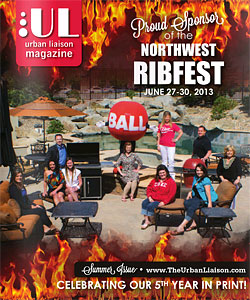 I have been fortunate to use The Urban Liaison Magazine with my various writing and communication classes for several years.
I have been fortunate to use The Urban Liaison Magazine with my various writing and communication classes for several years.The writing is snazzy, clear, correct and concise. It taps into themes and issues that are important to all types of consumers. By using a local angle, the essays and wonderful graphics keep my students engaged and provide powerful springboards for discussion.
This bi-monthly, community lifestyle magazine features the entire Treasure Valley, from Boise to Weiser. We offer complementary magazines to our readers which are distributed to over 700 businesses throughout the valley.
And during this time of massive cutback in education, you can’t beat the price for these classroom materials:
READ THE URBAN LIASON SUMMER ISSUE FOR FREE.
Cheryl Richard, publisher and founder, created the first 12 page magazine 4 years ago with the goal–to be a support system for the small businesses of downtown Nampa. In three short years the magazine expanded to include all of Canyon County. After the expansion into Weiser last year, plans to expand the magazine into Boise quickly began. The UL magazine is now between 68-72 pages. This immense growth is based upon the UL’s insistence upon their guiding philosophy–to be a support system to small businesses.
She wrote:
Our advertisers are promoted with a variety of ad options within our magazine and the magazine is also posted on our website and Facebook page. The featured stories in every issue are powerful tools that generate awareness for our advertisers business’s which brings new customers into their doors. Along with advertising in the magazine, the Urban Liaison will feature your business in our online directory, and provide a variety of posts and referrals through social media sites like Facebook and Twitter, which aim to educate our followers about our advertisers.The magazine is centered around telling our advertisers story; as a result all of our advertisers who purchase a half page ad or larger, that commit to the magazine for 6 issues will receive a story on their business! The additional articles feature interesting, positive pieces on our local community which includes non profits, events, festivals, music, and other local talent. While reading through each issue you will be inspired by our insistence on Local Living. We are the leader in Support Local in regards to print media.
The Urban Liaison features some of the most talented writers and graphic designers in the Treasure Valley which results in a beautiful, creative, and innovate product that will capture the story of your business in a way that resonates with readers. We offer the lowest prices in the valley for a full color, glossy, high end magazine. We’re one of very few publications that print 15,000 magazine per issue, with the intention to print 20,000 by next year, as advertising allows.The sole reason behind the magazine’s existence is to act as a voice for local business owners. A place to brand themselves, and create an image of their business, without breaking the bank during the process. If you want to brand your business and educate the consumers in the Treasure Valley, the Urban Liaison Magazine is the perfect solution to your marketing needs!
The Warrior’s Heart: Becoming a Man of Compassion and Courage
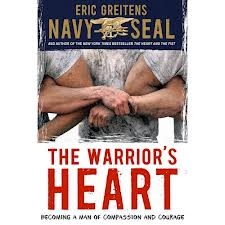 “It’s no small feat to make a difference in somebody’s life, and
Greitens has written a book that is a fitting honor to all the people
who made a difference in his. By sharing these stories with young
readers, he now has a chance to make a difference in a few more.”- The
New York Times
“It’s no small feat to make a difference in somebody’s life, and
Greitens has written a book that is a fitting honor to all the people
who made a difference in his. By sharing these stories with young
readers, he now has a chance to make a difference in a few more.”- The
New York TimesRegarding The Warrior’s Heart: Becoming a Man of Compassion and Courage, by Eric Greitens,
Amazon reviewer By Ken C. said:
The episodic nature of this book will make it a popular title on the nonfiction shelf. Greitens first talks about his experiences with boxing lessons and humanitarian trips to Bosnia, Rwanda, and Bolivia. Each serves as concrete evidence of the author’s self-discipline and commitment to others. And each is depicted in Greitens’ spare, straightforward writing style.From these early missions, the book moves into Greitens’ long road to becoming a Navy SEAL. The reader is treated to snapshots of many of his comrades and the training regime they suffered to become one of these rare warriors. Though never heavy-handed, Eric Greitens also uses the people he meets as character examples — men that inspired him. Young people should be moved by these examples, as well as by Greitens’ call to action at the end of the book, where he asks that they answer the call to serve by volunteering and making their world (country, town, school, neighborhood, family) a better place.In this adaptation of his best-selling book, The Heart and the Fist: The education of a humanitarian, the making of a Navy SEAL, Eric speaks directly to teen readers, interweaving memoir and intimate second-person narratives that ask the reader to put themselves in the shoes of himself and others. Readers will share in Eric’s evolution from average kid to globe-traveling humanitarian to warrior, training and serving with the most elite military outfit in the world: the Navy SEALs. Along the way, they’ll be asked to consider the power of choices, of making the decision each and every day to act with courage and compassion so that they grow to be tomorrow’s heroes. Sure to inspire and motivate.Here are some quotes from the book, along with a few of my thoughts:
Pg. 5″Like many American kids, I grew up learning about a world populated by heroes…. I worried that all the corners of the Earth had been explored, all the great battles fought…..My fear was that I’d miss my chance at a meaningful life.”What little kid doesn’t dream of making a difference? What little boy or girl doesn’t dream of being the hero or heroine. Whether they dream of being a policeman or firefighter, the momma or the one who breaks the spell, every child dreams of having the power to make a difference.
Pg. 6His parents had told him, ”perhaps since kindergarten–that I should work hard so I could go to a place called college. College, they promised, was the ticket…. I imagined the ticket as something golden and shiny, like a ticket for a train that would hurtle me to a place filled with adventures.”I identify with this because my parents wanted their children to go to college and I dreamed of it. As a parent, I encourage my children to prepare themselves for college and love to hear their dreams of the things they can do and become.
Pg. 137Eric hits it right on the head when he said of applying for a Rhodes Scholarship, ”…I had high hopes. Doing humanitarian work overseas, I realized it isn’t enough to fight for a better world: we also have to live lives worth fighting for.”How true.
Pg 176-177In Eric’s observation, “Many of the guys grew up in a culture where they’d inherited ideals about manhood from beer commercials and sitcoms. And whether the men they saw on TV were portrayed as overgrown and selfish boys, or as wimps and goofballs, the men who came to BUD/S knew—even if they didn’t articulate it–that there had to be more to being a man than that.” Eric illustrates the need that many young people feel in our society face. Too many young men and women need role models like the one Eric describes in his book: “Senior Chief Salazar…..was the eptiome of an excellent trainer. Every man in our class admired him…..That day on the beach …..he said, “You know what, guys? I want to tell you something about that it means to be a real frogman.” ”If you’re a real frogman,” he said, “then every time a woman leaves your side, she’ll feel better about herself.”Amen!I plan to read this book to my children because it shows a wonderful example of a life well-lived. The work demonstrates the kind of effort that we should each give to living and serving our country and each other. It also has many excellent observations and insights on the nature of service and about acting with courage and compassion.
What Can a Crane Pick Up? by Rebecca Kai Dotlich and other great picture books
What makes a good picture book?
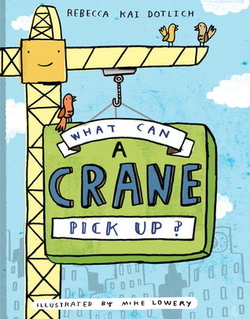 The first on my suggested list of new picture books that rise to this joyful level is:
The first on my suggested list of new picture books that rise to this joyful level is:
Remember what it’s like to see spring for the first time? To get your first grown-up bed? To run in the park, on the beach, along the Brooklyn Promenade, and never want to slow down? To find sneezes hilarious and wrapping paper the best toy in the world?wrote Marilyn Singer, author of more than 80 children’s books.
To write a good young picture book, you not only have to remember these things, you have to relive them. You have to write with all the skill of an adult who understands words, rhythm, rhyme, character, and story and all the heart and soul of a child who understands joy, anger, sorrow, and wonder in their purest form. It’s the wedding of our present and past selves that allows us to write a good young picture book. Then the illustrator completes the picture in every sense of the word.
 The first on my suggested list of new picture books that rise to this joyful level is:
The first on my suggested list of new picture books that rise to this joyful level is:
What Can a Crane Pick Up? by Rebecca Kai Dotlich; illustrated by Mike Lowery: An inviting rhyming read-aloud about the many surprising things a crane can pick up.
“All hail the crane! It’s clear that this machine lives in the best of all possible worlds: where happiness is busyness, calm competence prevails, and no job is too small. Sign us up.” —Publishers Weekly, StarredFrom poet Rebecca Kai Dotlich and artist Mike Lowery comes WHAT CAN A CRANE PICK UP?, a rollicking picture book about cranes—the kind that pick things up! We start with pipes and bricks and loads of steel and then move on to funny, whimsical objects: a cow, a Ferris wheel, men in business suits, and an ancient mummy’s case. With a rhyme that begs to be read aloud again and again, and quirky, exuberant illustrations, this book is sure to delight kids and parents alike. But watch out: Cranes pick UP—that’s what they do! Look out, or a crane might pick up you!
Annie and Helen by Deborah Hopkinson; illustrated by Raul Colón: A tender nonfiction portrait of the relationship between Annie Sullivan and Helen Keller
This Is Not My Hat, by Jon Klassen (Author, Illustrator): From the creator of the #1 New York Times best-selling and award-winning I Want My Hat Back comes a second wry tale.
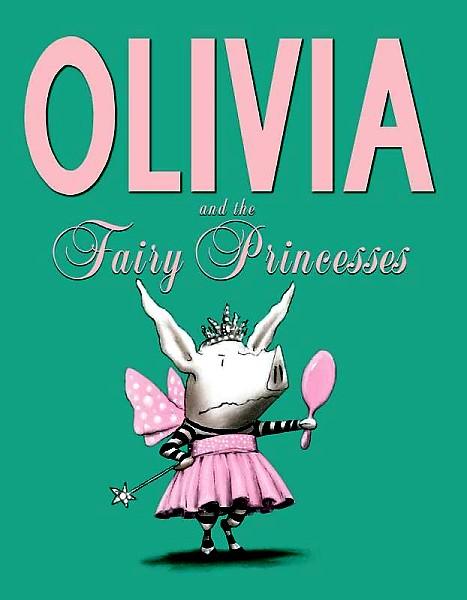 When a tiny fish shoots into view wearing a round blue topper (which happens to fit him perfectly), trouble could
be following close behind. So it’s a good thing that enormous fish
won’t wake up. And even if he does, it’s not like he’ll ever know
what happened. . . . Visual humor swims to the fore as the best-selling
Jon Klassen follows his breakout debut with another deadpan-funny tale.
When a tiny fish shoots into view wearing a round blue topper (which happens to fit him perfectly), trouble could
be following close behind. So it’s a good thing that enormous fish
won’t wake up. And even if he does, it’s not like he’ll ever know
what happened. . . . Visual humor swims to the fore as the best-selling
Jon Klassen follows his breakout debut with another deadpan-funny tale.
Olivia and the Fairy Princesses, by Ian Falconer (Author, Illustrator): In this picture book starring the world’s most imaginative pig, Olivia embarks upon a quest for identity with very lofty goals €”and being a princess is NOT one of them!
“What is breathtakingly shown here, through accurate, cross-hatched watercolor paintings; excerpts from Sullivan’s correspondence to her former teacher; and concise and poetic language, is the woman’s patience and belief in the intelligence of her student to grasp the concepts of language.”—School Library Journal,Author Deborah Hopkinson and illustrator Raul Colón present the story of Helen Keller in a fresh and original way that is perfect for young children. Focusing on the relationship between Helen and her teacher, Annie Sullivan, the book is interspersed with excerpts of Annie’s letters home, written as she struggled with her angry, wild pupil. But slowly, with devotion and determination, Annie teaches Helen finger spelling and braille, letters, and sentences. As Helen comes to understand language and starts to communicate, she connects for the first time with her family and the world around her.The lyrical text and exquisite art will make this fascinating story a favorite with young readers. Children will also enjoy learning the Braille alphabet, which is embossed on the back cover of the jacket.
This Is Not My Hat, by Jon Klassen (Author, Illustrator): From the creator of the #1 New York Times best-selling and award-winning I Want My Hat Back comes a second wry tale.
 When a tiny fish shoots into view wearing a round blue topper (which happens to fit him perfectly), trouble could
be following close behind. So it’s a good thing that enormous fish
won’t wake up. And even if he does, it’s not like he’ll ever know
what happened. . . . Visual humor swims to the fore as the best-selling
Jon Klassen follows his breakout debut with another deadpan-funny tale.
When a tiny fish shoots into view wearing a round blue topper (which happens to fit him perfectly), trouble could
be following close behind. So it’s a good thing that enormous fish
won’t wake up. And even if he does, it’s not like he’ll ever know
what happened. . . . Visual humor swims to the fore as the best-selling
Jon Klassen follows his breakout debut with another deadpan-funny tale.Olivia and the Fairy Princesses, by Ian Falconer (Author, Illustrator): In this picture book starring the world’s most imaginative pig, Olivia embarks upon a quest for identity with very lofty goals €”and being a princess is NOT one of them!
Olivia is having an identity crisis! There are too many ruffly, sparkly
princesses around these days, and Olivia has had quite enough. She needs
to stand out! She has to be special! She wants to do more than just fit
in! So what will she be?Join Olivia on a hilarious quest for
individuality, and rest assured, you won’t find THIS pig pleased to be
in pink!
Big Girl Panties! by Fran Manushkin; Illustrated by Valeria Petrone: This book puts a fresh, fun, and positive spin on potty training, told with imagination and humor from the child’s point of view. BIG GIRL PANTIES! features a light, positive approach to motivate toddlers to become toilet trained. What could be more rewarding for a little girl than wearing big girl panties, just like mommy? Adult caregivers and toddlers alike will love the snappy, rhyming text and colorful, hip illustrations. Valeria Petrone’s stylized artwork ensures that this commercial yet heartwarming book will have a special place on little girls’ favorite bookshelves. Soon they’ll all be saying, “Bye, bye diapers!”
Lemonade in Winter: A Book About Two Kids Counting Money by Emily Jenkins; illustrated by G. Brian Karas: A fun read-aloud AND an introduction to simple money math—a dream for teachers, librarians, and parents.
A lemonade stand in winter? Yes, that’s exactly what Pauline and John-John intend to have, selling lemonade and limeade—and also lemon-limeade. With a catchy refrain (Lemon lemon LIME, Lemon LIMEADE! Lemon lemon LIME, Lemon LEMONADE!), plus simple math concepts throughout, here is a read-aloud that’s great for storytime and classroom use, and is sure to be a hit among the legions of Jenkins and Karas fans.
Railroad Hank by Lisa Moser; illustrated by Benji Davies: CHUGGA-CHUGGA, CHUGGA-CHUGGA, WOO-WOO-WOO!
Injected with Lisa Moser’s trademark humor, RAILROAD HANK celebrates the powerful bond of friendship. When Hank finds out Granny Bett is feeling down, he enlists the help of his neighbors to find a way to cheer her up. Wandering the countryside, Hank befriends all sorts of fun characters, from Missy May, who thinks there’s nothing better than scrambley eggs to bring a smile to someone’s face, to Cinnamon Cobbler, who swears by a fresh-picked apple as the cure-all to any sadness. Readers will laugh together over Hank’s many goodhearted blunders – from uprooting an apple tree to scooping up all the water from Reel-‘Em-In Sam’s pond.
Who Pushed Humpty Dumpty? And Other Notorious Nursery Tale Mysteries by David Levinthal; illustrated by John Nickle: Nursery tale ne’er-do-wells receive justice at the hands of Officer Binky in this humorous, noir-style retelling of classic stories.
“Humorous retellings, cast in the world of hard-boiled crime and private detectives.”—The New York TimesBreak in at the Three Bears family home? It could only be one dame. Wicked witch gone missing from her candied cottage? Hansel and Gretel claim it was self-defense. Did Humpty Dumpty really just fall off that wall, or was he pushed? Here are five fairy-tale stories with a twist, all told from the point of view of a streetwise police officer called Binky, who just happens to be a toad in a suit and a fedora. When Snow White doesn’t make it to the beauty pageant, Officer Binky is the first to find the apple core lying by her bed. When an awful giant mysteriously crashes to the ground, upsetting the whole town, Binky discovers exactly who is responsible.
Room for the Baby by Michelle Edwards; illustrated by Jana Christy: A family needs a place to put a new baby, but the only space in the house is a jam-packed room that has to be emptied first—not as simple a task as it may seem.
National Jewish Book Award–winning author Michelle Edwards provides a fresh take on repurposing and crafts in ROOM FOR THE BABY, the delightful story of one family putting everyday items back to good use as they quickly prepare for their latest addition. The big brother-to-be is worried—a baby is on the way, but there is no place to put the crib! His mom does have a sewing room, but its every nook and cranny is stuffed with cast-off items and outgrown clothes that people have given her to recycle and reuse—some day. Now that day has come—because the new arrival will need someplace to sleep and something to wear. So the resourceful mom gets to work, making new clothes from old to outfit the baby-to-be.
Inspired by her creativity, the neighbors get involved, and soon everyone is stitching and knitting something. As the months go by and the family celebrates the Jewish holidays from Passover to Hanukkah, big brother helps his mom get ready, too. But things move slowly and he continues to worry: will there ever be room for the baby? Filled with vibrant illustrations, children will love watching as little by little the sewing room is transformed.
The Chicken Problem by Jennifer Oxley and Billy Aronson: What do you get when you add Peg and Cat, multiplied by dozens of baby chicks, and then divide them all with one farm. You get . . . The Chicken Problem!
Full of humor, refreshingly original characters, and math problems that young readers will be clamoring to help solve, THE CHICKEN PROBLEM is an ideal addition to the home or classroom. Left-brained Peg and her right-brained pal, Cat, are enjoying a picnic on the farm with Pig. However, when someone leaves the chicken coop open and the chicks run-a-muck, it’s up to Peg and Cat to use their math skills to help solve their poultry predicament.
Illustrated by Emmy-winning animators, this picture book is packed with farm-inspired counting and is a fun and refreshing take on learning math.
What makes a good picture book?
1. Rhythm in both text and art.2. A tight text rich in language.writes Denise Fleming, author of Buster, In the Small, Small Pond, and In the Tall, Tall Grass.
3. Use of repetition or refrain which encourages the listeners to
participate.
4. A sense of playfulness and joy.
5. And rhyme, when it works, is a plus.
The books on this list will enrich your home or classroom library for years to come.
Subscribe to:
Posts (Atom)
